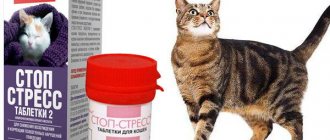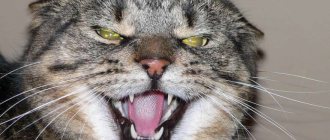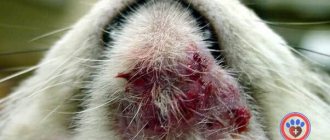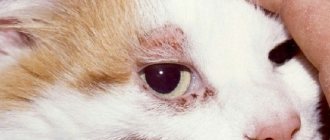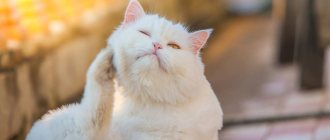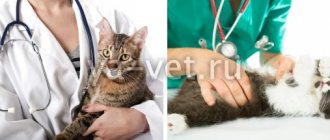Depression and blues in the cat family
- Fact:
Cutting nails, vaccinations, and bathing have a very negative impact on the cat’s emotional well-being. - Fact 2:
A panic attack in a new place is a standard reaction of a pet to moving. - Fact 3:
The loss of a beloved owner is perhaps the biggest nervous shock for any animal. - Fact 4:
You can use drugs like Kot Bayun and others
Animals have no less reasons than people to experience stress. After all, they also don’t like a lot of things in the surrounding reality, but unlike a person, a cat is not always able to withstand nervous stress. Whatever one may say, the life, actions and activities of a pet are largely determined by the owner and sometimes contrary to his own wishes. However, it is also in his power to bring relief to his beloved pussy. In order to better understand your ward, help and calm her in critical conditions, every caring owner of a tailed friend should learn better why the animal falls into a state of stress, how this manifests itself, how to help, calm and comfort her.
What is stress and what are its consequences?
When any irritating factors begin to affect the body, the reaction follows immediately. Negative suppression of the nervous system and a state of tension lead to disruption of the psycho-emotional background, its disorder and changes in behavior. A sharp surge of irritation leads to an acute state of stress, and a regular negative effect on the central nervous system leads to a chronic feeling of depression.
When a pet begins to feel unhappy, its body begins to express this in various ways:
- There is an increase in blood pressure.
- Immune functions decrease.
- Breathing becomes rapid.
- Resistance to disease weakens.
- Heart rate increases.
- The functioning of the gastrointestinal tract is disrupted.
In an acute condition, such symptoms are not dangerous for the animal, will not leave consequences and will go away quite easily. But the chronic course of stress can lead to serious complications, provoke physical and psychological exhaustion, and can even take away a significant part of the tailed pet’s life.
Possible consequences
Fright is not harmless to a cat. It can disrupt habitual patterns of behavior and affect health.
Most often, the consequences are negative, ranging from banal fear, loss of confidence and body weight of the pet, ending with numerous disorders of the body, especially mental changes affecting the behavior of the pet (desire to hide, timidity, aggressiveness, apathy, etc.), and disruptions of the immune system leading to to the occurrence of infectious diseases.
In addition, the organs of the genitourinary system and gastrointestinal tract are subject to stress.
Possible consequences may include various dermatitis and eczema, attacks of hypertension. In the worst case, death is possible.
What causes stress in an animal?
Cats and cats really don’t like it when something changes in their well-established lives. A familiar way of life and a measured existence provide the same psychological comfort in which the animal feels satisfied and happy. Any deviations from the established way of life cause a negative perception in the pet.
Scientists identify the following situations as the most common and widespread causes of mental discomfort:
- Animal disease . When a pet suffers from pathological conditions, and the owner shows indifference about this and does not treat the cat, then, against the backdrop of indifference, she may develop stress, which will only aggravate the already difficult situation of the poor thing.
- Procedures related to hygiene and medical procedures (nail cutting, vaccinations, surgical interventions, bathing and other activities) have a very negative impact on the cat’s emotional well-being.
- Change of place of residence . A panic attack in a new place is a standard reaction of a pet to moving.
- Restriction of freedom of movement . Forced to constantly be in a confined space, the poor creature falls into melancholy, and then into a depressive state. Suppression of physical activity and satisfaction of desires is a great stress for the pet.
- or other pets in the family Jealous furry creatures have great difficulty enduring the appearance of “competitors” and the need to share the owner’s attention with someone else. In addition, having a baby for the pussy often results in the introduction of many prohibitions (sleeping on the bed, going into the nursery, etc.).
- Participation in various exhibitions , competitions, etc. The accumulation of a large number of people and other animals leads individual felines into indescribable horror, turning into deep stress.
- Trips . The need for some long trips, especially in public transport, leaves an indelible imprint on the cat’s psyche for a long time.
- Change of owner . The loss of a beloved owner is perhaps the biggest nervous shock for any animal. And especially for a sensitive, easily bonded cat.
Sometimes the exact opposite happens. Intemperate owners so often and violently express their delight at the presence of a pussy that the poor animal simply cannot stand the constant forced affection, literally fleeing from its loving owners. Although an affectionate creature, she is naturally independent at heart; a cat often falls into stress from such overprotection.
Main stages
After making sure that your cat is stressed, you should find out at what stage the problem is. It doesn’t matter what type of stress the pet has been exposed to, the main thing is to understand that almost any negative effect on the cat has a common manifestation.
Officially, scientists distinguish 3 stages of stress:
In the first stage of stress, the body mobilizes to face potential danger.Stage of anxiety (mobilization).
The most invisible stage for owners, as it is easily confused with temporary emotional arousal. It is characterized by the inclusion of all adaptive capabilities of the body to overcome difficulties associated with stress. If the cause is too strong and the pet is not able to fight it, then death is possible. Externally, this manifests itself in increased breathing, decreased body temperature and decreased tone. Excessive excitability or apathy appears.- Resistance stage. The calmest stage: anxiety subsides, the cat’s body is rebuilt and is temporarily able to cope with the stressor that has arisen. Despite this, the animal may outwardly show signs of stress, especially if the struggle with difficulties lasts for quite a long time. Most often, it is at this stage that owners notice that “something wrong” is happening to the animal. The duration of the stage depends on the ability to deal with the stressor and on the strength of the stressor itself.
- Exhaustion phase. The most noticeable and sad stage. Although the body was able to deal with stress, its resources are not endless. If the cause of the difficulties was physical, then the cat, at best, will face a full recovery after a long time, and at worst, death.
It follows from this that if a cat is having a hard time and is seriously suffering from stress, then urgent measures are needed to eliminate the stress in the pet, otherwise the consequences may be irreversible.
Stress resistance as a hereditary factor
Even in the same family, under the same conditions, two cats living together behave differently in stressful situations. Why do some animals react violently to external stimuli, while others show only mild anxiety?
It's all about genetic disposition and the condition of the mother during pregnancy. A cat that was exposed to stressful situations while expecting offspring, unfortunately, will not give her kittens a healthy nervous system. This means that even before birth they will have a weak resistance to negative factors.
The next stage in the development of stress resistance will be the childhood of a prankster. If he is constantly prohibited from realizing his natural needs to study the world around him, then problems with the adequacy of behavior, socialization and perception of the environment are guaranteed.
Causes
In the same situations, one cat experiences stress, but the other does not. This happens because the nervous system, resistance to stress and speed of adaptation are different for all individuals.
Different perceptions of external stimuli depend on the habits of the animal. What is normal for one is stressful for another.
The causes of stress are divided into several types:
- physical - burns or frostbite, too hot or very cold, high humidity, injuries;
- chemical - poisoning, smoke in the room;
- biological - hunger, lack of vitamins in the body, long-term illness;
- mental – fear, change of environment, changes in routine.
The most common cause is mental. It is connected with the environment. Any deviation from your usual lifestyle can cause stress. Lack of attention, loneliness, changes in feeding habits are the causes of disruption of the nervous system.
It has also been noted that among representatives of the cat family, the habit of their habitat is more developed than their attachment to humans. Separation from home is a serious health threat. It is better to agree with your family or friends to look after the animal during your absence rather than change the situation. There are cases when, after moving, a cat completely refused to eat for 10 days, only drinking water.
In addition to moving, cats find it difficult to tolerate changes in the environment in the house where they live. Changing furniture, repairs, rearranging, the appearance of a new cat or other animal, frequent guests are the causes of stress.
Cats perceive the psychological atmosphere in the house very keenly. The owner's stressful state is transmitted to the animal.
Acute stress conditions
It is very important to be able to distinguish between different emotional types in order to properly provide psychological assistance to the animal. An acute condition is expressed by the following symptoms:
- The pet freezes, but the body may shake slightly, as if in a chill.
- The animal may involuntarily wet itself or perform an act of uncontrolled defecation.
- The tail clings tightly to the body, the snakes descend to the head. and the mustache leans down onto the cheeks.
- The pupils become dilated.
- Breathing is frequent and short.
- Profuse salivation begins.
- The pet meows inwardly with a hiss, and even growls.
- An attack of aggression occurs when approached too close.
To calm the animal, it is enough to get rid of the source of irritation and the pet’s behavior will return to normal quickly and painlessly. In such situations, it is important to understand what exactly triggered the attack of stressful behavior.
Treating Feline Stress
To bring the animal back to normal, an integrated approach is needed. This includes psychological help from the owner and medications. Non-hormonal drugs can be used as medicine.
But the main thing is to start by identifying the cause and eliminating it, if possible. You should also provide your pet with extra attention and games. You need to distract the cat from its condition and involve it in the game.
You can also get rid of stress through training, when the pet’s physical strength is mobilized to overcome various difficulties. Stroke the cat, talk to it, offer your favorite treats. You should switch to medications only after consulting a doctor.
Prolonged chronic stress
If the unfortunate animal is constantly depressed, her body will gradually adapt and may not show the symptoms described above. However, she develops other habits and signs that indicate serious, advanced mental and physiological problems:
- The pet has a craving for secluded places.
- He sleeps a lot and for a long time. The more aggravated the condition, the more time the patient spends sleeping.
- In addition to intestinal dysfunction, problems with the gastrointestinal tract, vomiting, and nausea are added.
- Indifference to food or, conversely, extreme appetite appears.
- The slightest noise or appearance of a person causes anxiety and fear.
- The animal begins to defecate past the tray and mark corners in the apartment.
- Aggression appears towards everyone present in the house, from people to other animals. Sometimes this even extends to objects.
- Passivity and lethargy appear, the cat avoids any company, preferring it to solitude.
- She becomes unkempt, does not take care of her fur, or, on the contrary, manically licks her fur coat, sometimes until bald spots appear.
Such animal conditions require prompt treatment, which will require maximum affection, patience and care.
Preventing stress
Knowing about upcoming changes in your lifestyle or your pet's environment, you should try to prevent stress from occurring.
It is advisable for the animal to have its own corner in the house, which should be arranged in a warm, sunny place, fenced off from the access of other people. While waiting for guests, it is better to leave the cat there and not allow strangers to invade its territory. Don't let children play with your cat unless she wants to.
To avoid stress after changing your place of residence, immediately take out her bed and toys, and place a bowl of water. It would be a good idea to bring an old litter tray to your new home.
Do not leave your pet alone for a long time in a new room. Do not restrict access to the window - they love to watch what is happening on the street.
What to do if your cat is stressed
The first step when stress appears in your beloved pet is to determine the cause that caused it. If possible, you need to get rid of it. Of course, it is impossible for the sake of a cat to return, for example, to his previous place of residence, or to resurrect a deceased former owner, or to get rid of a newborn child. But it is quite possible to mitigate less drastic situations (relocate another pet, do not take the pet to the clinic, but call a doctor at home, refuse to participate in exhibitions).
If you cannot change the situation, change your attitude towards it. Or rather, the attitude of your pet. There are two ways to try to soften the situation and gradually reconcile the animal with factors that are negative in its understanding.
Option 1. Psychological:
- protect the cat as much as possible from contact with “undesirable” objects;
- distract the pet’s attention, trying to switch it to pleasant activities, toys, treats;
- calm down with tactile contact during procedures that are unpleasant for the pussy, talk gently, stroke;
- express your love more often, talk, stroke, massage, and under no circumstances express irritation in any situation.
If the measures taken are clearly not enough, then you will have to resort to medications to help the animal overcome anxiety states.
Option 2. Medication:
- Pheromones . Veterinary pharmacies offer various aerosols of synthetic origin, the composition of which is identical to natural cat pheromones. When spraying the spray, the animal will feel emotional uplift and security.
- Antidepressants . Sometimes the doctor prescribes medications for your pet that are also used to treat people (Valium, Diazepam, etc.).
- Combined therapeutic agents . The combination of natural and chemical substances has a sedative effect (prescribed by a doctor!).
- Essential oils . Calming with aromatherapy (aroma lamps, sticks) gives a good relaxing result.
- Herbs. With the help of catnip you can achieve calm after a short phase of excitement (do not replace it with valerian!).
- Collar . A neck decoration imbued with a complex of essential oils and pheromones is a good way to get out of a depressive state and discourage a cat from licking its fur.
To avoid stressful situations or minimize their consequences, it is better to prepare your cat ahead of time for negative events. For example, use drugs that have a cumulative effect and start giving them in advance, 5-7 days in advance (Kot Bayun, Fitex, etc.).
How to calm a cat after stress
If you cannot avoid a stressful situation, you need to help your cat cope with stress.
The owner’s algorithm of actions should be as follows:
- Find and eliminate the cause of stress.
- Divert the cat's attention from the stress factor with the help of games, favorite toys, treats, and affection.
- Offer physical activity. Sports playgrounds for cats or a walk in the fresh air will help with this. Physical activity effectively distracts and entertains the animal. However, you need to ensure that physical activity is commensurate with the age and condition of the pet. Overload is additional stress for the cat’s nervous system.
- Give the cat a lot of attention. Stroke your pet, talk to him affectionately, scratch behind the ear. Do whatever makes him happy and relaxes.
- Use aromatherapy. The aroma of bergamot, mint and lavender causes a sedative effect in cats, this will help calm the cat after stress.
- Adjust your cat's diet. After stress, cats benefit from: fish oil, sea fish, olive oil, quail eggs.
What to give your cat for stress
All sedatives that will help relieve stress in a cat should be prescribed by a veterinarian. Do not self-medicate so as not to aggravate the situation and increase stress. Next, let's talk about what you can give your cat for stress.
Types of sedatives:
- drops;
- pills;
- collars;
- spray.
Anti-stress medications for cats:
- Stop stress, Api-San. A medicinal modulator of cat behavior based on the drug phenibut and a complex of plant extracts: hops, peony, motherwort, Baikal skullcap. Price: 160 – 175 rub.
- Stop stress plus. Relieves excitability, fear and aggression. Price: 200 – 230 rub.
- Relaxivet. Calming tablets for animals. Price: 150 – 65 rub.
- Relaxivet, calming spray. Therapeutic cosmetics that correct cat behavior. Price: 220 – 250 rub.
- Beaphar No Stress Spot On. Soothing drops in pipettes. Price: 600 – 650 rub.
- Beaphar No Stress Home. Spray for correcting cat behavior after stress. Price: 690 – 750 rub.
- GOOD No stress. Homeopathic collar for cats with valerian extract. Price: 350 – 380 rub.
How to help your pet
There are ways to overcome stress through various games and techniques. They help develop the ability to independently cope with stress, and can also direct your pet's activity to improve dexterity and reflexes.
- Distraction method. Well suited for switching attention from a stressor to other events. To do this, you should surround the cat with care and attention. A good method may be an interactive toy that does not require the attention of the pet owner. The main thing is to distract and entertain your pet.
- Immersion method. The essence of this method is to immerse the cat in a real situation of stress, but only under the supervision of the owner of the animal or a specialist. To avoid a nervous breakdown in your pet, this method should be carried out carefully so as not to worsen the condition.
- "Occupational therapy". To successfully implement “occupational therapy” for a cat, you can arrange for it a variety of obstacles with physical activity commensurate with it. Training is also good because it will not only help you cope with stress, but also discipline your pet.
- Help from an animal psychologist who will identify the cause of stress and develop a list of measures to adapt the animal.
Of course, treatment methods are not limited to this list.
For example, one of the treatment methods may be the organization of personal space. Research in shelters has shown that a regular cardboard box is an excellent way to relieve cat stress (video):
